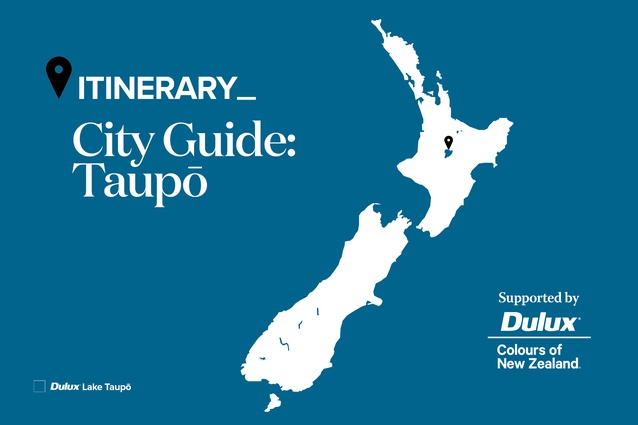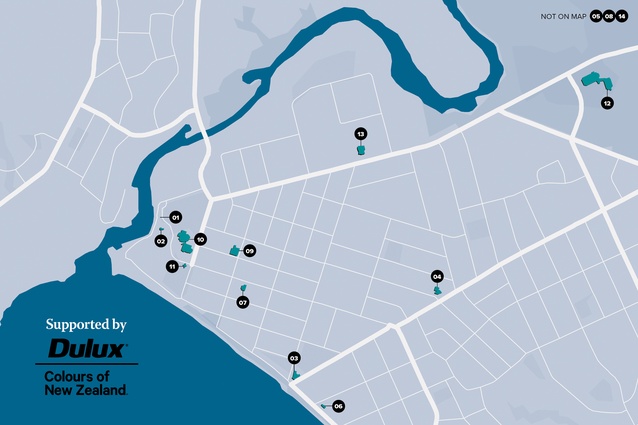Itinerary_ City Guide: Taupō
In this month's Itinerary, supported by Dulux Colours of New Zealand, Andrew Barrie and Terry Cheng highlight fourteen historic sites across Taupō.
Lake Taupō and the surrounding thermal areas had long been home to Māori, with a substantial community at Tapuaeharuru in the vicinity of the current Taupō township. Significant colonial habitation began with the creation of a redoubt at the strategic crossing of the Waikato River, where it connected to the lake, and across the river from the pā of Te Poihipi Tukairangi, a chief sympathetic to the settlers.
The Armed Constabulary stationed at the redoubt carried out construction work and ‘the keeping of order’. Although the Armed Constabulary was disbanded in the mid-1880s, its presence meant the town had the advantages of telegraph, post and roads, which encouraged the development of shops and hotels around the main road and mooring. In 1887, at the local courthouse (see listing 02), Ngāti Tūwharetoa paramount chief Horonuku Te Heuheu Tūkino IV signed a deed offering up the summits of Ruapehu, Tongariro and Ngāuruhoe to form the nucleus of the nation’s first national park, and just the fourth in the world.
Despite this long history and strategic position, what is remarkable about Taupō is how slow it has been to develop. The town has only two Heritage New Zealand Pouhere Taonga listed sites.
After World War II, the population was only 750 and, even as huge hydroelectric and geothermal power projects got under way in the district, through the middle of the century, the downtown area was little more than a few sparsely occupied blocks. A modest burst of civic building in the 1960s provided amenities that cemented the town’s role as the key service centre for the district.
However, while Taupō’s collection of public and commercial buildings is relatively unassuming, it has accumulated exciting houses by leading architects from around the country, including David and Lillian Chrystall, Gummer & Ford & Partners, John Scott and Claude Megson. More recently, the town has gained award-winning houses by Charissa Snijders, Wendy Shacklock, Peddle Thorp and Crosson Clarke Carnachan, as well as by locals such as Fraser Cameron. On any visit, a quick scan of the real estate listings will almost certainly turn up a topnotch house that is open to view.
Despite the attractions of mountains, forests, lakes, rivers and thermal waters, and while being only a half-day drive from home for most of the North Island’s population, Taupō has picked up only a little of the glamour of comparable Queenstown.
In some ways, the town is a time capsule. The focus of outdoor recreation has shifted in New Zealand, with the rise of adventure tourism, the clearing of rumpty baches to make way for luxurious holiday houses, and the advent of ‘glamping’. Once a deliberate escape from the comforts and sophistications of daily life, the outdoors now seems to be a source of ‘luxury’ experiences: less Barry Crump, more Huka Lodge. Architecture has been key to this re-focusing. But, as noted above, where this exists in Taupō, it is mostly tucked out of sight in private houses. At a time when we must urgently find ways to consume less, such modesty takes on new appeal.
THE ITINERARY
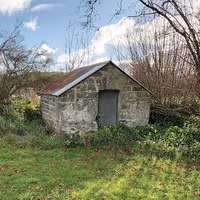
1. 1870 – Redoubt and Magazine
23 Story Place
Armed Constabulary
Part of a chain of Armed Constabulary (AC) posts along the Napier–Taupō Road, the redoubt was established in 1870 to guard the strategic crossing of the Waikato River near its outflow from Lake Taupō. Located on key east-west and north-south routes, the redoubt became the regional headquarters of the AC. Designed to accommodate 150 in tents, it was occupied by much smaller numbers. A series of buildings was erected in and around the defences, with the fireproof magazine built in 1874 for storage of explosives. The AC was withdrawn in the 1880s and soon disbanded, being replaced with a civil police force.
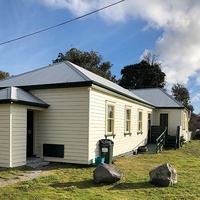
2. 1881 – Taupō Courthouse (former)
23 Story Place
Armed Constabulary
By 1877, Taupō township had been laid out and the redoubt elevated to be the regional headquarters of the Armed Constabulary. A Category 2 historic place, this building was built by AC members as both a courthouse and a hall for their own use. The building was still in service as a court until 1962, when a new building was constructed. It was moved to its present location in 1964. Tongariro Domain and the marina down on the riverfront reward exploration — just a moment’s walk from the Courthouse, the Taupō Museum is well worth a look.
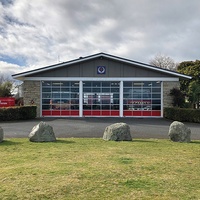
3. 1961 – Taupō Fire Station
70 Lake Terrace
Ewen Christie & Associates
Working for other firms and under his own banner, local architect Ewen Christie undertook numerous projects around town through the 1950s, ’60s and ’70s. The Fire Station, one of Christie’s earlier solo projects, was part of a burst of public building in the early 1960s. The building looks original but has been sensitively expanded over the years — most particularly, an extra fire engine bay was seamlessly added. In 1969, Christie completed offices for Taupō County Council across the street from the Fire Station, forming a second civic hub for the town, but this was demolished in 2018 because of issues including asbestos.
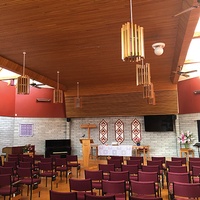
4. 1963 – St Paul’s Union Church
172 Tamamutu Street
Ewen Christie & Associates
Taupō’s first church was designed and built in 1913 by Reverend Henry Fletcher, the town’s first Presbyterian minister. That building now stands at 2 The Boulevard, near Huka Falls, having been replaced in stages in the 1960s and 1970s. The glulam portal-framed hall was first and, after the congregation combined with the local Methodists in 1971, the brick-walled and dramatically top-lit worship space was added in 1977. Christie enthusiasts might check out the former Dalgety’s premises (1964, now Harcourts) on the corner of Te Heuheu and Ruapehu Streets, and Suncourt Plaza (1969) at 19 Tamamutu Street.
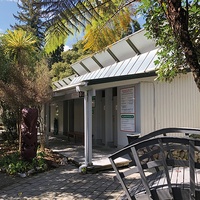
5. 1967 – DeBretts Hot Pools Complex
76 Napier Road, Waipāhīhī
JASMaD
A very early JASMaD project, this complex originally consisted of some private pools, and forthright changing sheds closely wrapped around a series of hot pools. These original structures are still recognisable, though now bookended by hydroslides and spa facilities. The contrast between the simplicity of the original and the newer facilities on the site demonstrates the glam-ification of outdoor experiences that has occurred in New Zealand over the space of two generations. Where heading outdoors might have been a moment for simple pleasures, it has now been fully absorbed into our systems of consumption. See Home & Building March/April 1968.
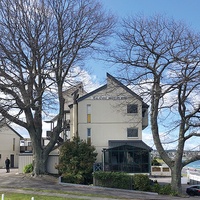
6. 1974 – Tui Oaks Motel
84 Lake Terrace
E. T. Smith, McNaught & Co
Taupō-based architect Eric Smith was involved in a series of firms that completed projects of diverse types — offices, hospitality, old folks’ homes — in locations spanning from Whangārei to central Auckland to Tīmaru. These firms remained largely under the radar, and the architectural language was typically straightforward and modest — concrete block, pre-cast concrete, exposed timber — but the buildings were boldly composed and stylish, and many are still in close-to-original condition. Across the road at 82 Lake Terrace is The Village Resort, completed as a timeshare in 1988 by New Plymouth-based firm Boon Smythe Goldsmith Architects. See Architecture NZ Nov/Dec 1988.
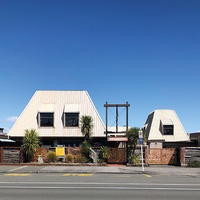
7. 1977 – Real Estate House (former)
65 Te Heuheu Street
Denniston and Hodgson
Denniston and Hodgson was an iteration of a long-running commercially oriented firm based in Tauranga. Its output includes a string of award-winning projects, and the 1970s’ and early 1980s’ projects still look particularly sharp. It was aligned with the highly geometric work that was produced by several leading New Zealand firms, including Warren and Mahoney and John Blair, before the PoMo impulse swept across the nation. Originally housing various company offices as well as a restaurant and hair salon, this building was converted to a backpackers’ hostel, but fans of 1970s’ design should note the building is currently for sale. Refer Home & Building March/April 1979.
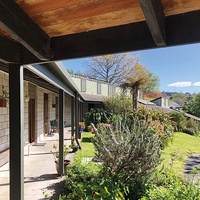
8. 1977 – Tauhara Retreat & Conference Centre
60 Acacia Heights Drive, Acacia Bay
Mercer & Rae & Associates
In the 1960s, intending to create a non-denominational centre for live-in seminars, retreats and conferences, Tauhara’s charitable trust engaged a London-based architect, who generated a classically informed scheme. Designs were eventually sought from Hamilton architect Barry Rae, who completed the complex in stages. The centre is located on a dramatic site with wide views across the lake to Taupō township and to Mount Ruapehu, but Rae’s meandering design is embedded into the contours and vegetation to create a charming compound tied together with intimately scaled verandahs and sheltered outdoor spaces. Refer New Zealand Architect, no. 2, 1981.
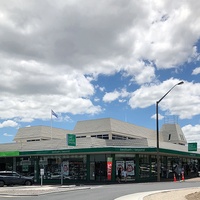
9. 1985 – Post Office (former)
46 Horomātangi Street
Denniston and Hodgson
The presence of a Post Office was one of early Taupō’s advantages. A substantial, purpose-built building, the town’s third Post Office was erected in 1911 — it was later incorporated into the Taupō Museum but only fragments survive. This 1980s’ version was received with fanfare but, as in most small towns, the post office facilities themselves are long gone, although the dramatic envelope is still clear. Denniston and Hodgson also completed an award-winning but recently demolished terminal at Taupō Airport (1982) and a still-extant high-end fashion store (1983) down the block from the Post Office on the corner of Te Heuheu and Tongariro Streets.
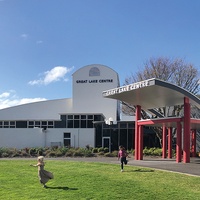
10. 1992 – Great Lake Centre
Story Place
Dodd Paterson Newman Pearce Architects Collaborative
Dodd Paterson et al. was the last in a long line of firms that had begun in 1960 with the Auckland partnership of enfants terribles Rolly Adams and Brian Dodd. The Architects Collaborative firm is best known for the former Auckland Harbour Board Building (1983) on the landward end of Princes Wharf in downtown Auckland, perhaps the closest New Zealand ever got to Metabolism. The Great Lake Centre complex includes a 350-seat theatre, a hall to seat 500, a tourist information centre, a new local public library and the district’s war memorial. Refer Architecture NZ Nov/Dec 1992 and Home & Building Oct/Nov 1992.
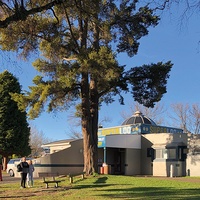
11. 1993 – Taupō Superloo
Story Place
Sandy Geddes & Associates with Jenkins, Roberts & Associates
Opening just after the adjacent Great Lake Centre, the Superloo offered tourists well-appointed and regularly serviced toilet, shower and locker facilities, but created a sensation by charging users for the privilege. User-pays has its upside, with the facility frequently rated among the best public toilets in the nation (the Hundertwasser toilets in Kawakawa usually taking the top place). In 2022, in the wake of pandemic-induced requirements to suspend charges, the Superloo toilet fees were dropped entirely. It still costs $5 for a shower but this includes a towel, shampoo and soap. Enjoy!
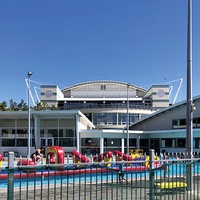
12. 1998 – Taupō Events Centre
26 AC Baths Avenue
Creative Spaces
This PoMo-infused, high-tech sports and recreation centre is organised around a huge sports hall. The hall’s roof structure, designed by international engineering firm Ove Arup & Partners, is the project’s defining element — a thin arc that combines steel trusses and laminated timber beams, all supported on tension cables and rows of slender masts that run down the building’s long façades. The overall effect is highly dynamic and, in concert with an undulating walkway canopy, vaguely nautical. Refer Architecture NZ May/June 1998 and Sept/Oct 1999. The complex also includes the 2014 rebuilding of the AC Baths by Boon Goldsmith Bhaskar Brebner Team Architects.
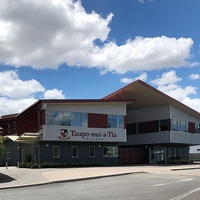
13. 2012 – Taupo-nui-a-Tia College
122 Spa Road
Ignite
With more than 1,000 students in a town of 26,000, this school plays a large role in Taupō’s community life. Ignite provided a master plan and a series of interventions and renovations across the school campus, including rebuilding the gymnasium in 2011 on the Waikato Street frontage so it could also serve effectively as a community facility. The two-storey Design and Innovation Centre on Spa Road, opened in 2012, includes classrooms to suit contemporary teaching methods, computer suites and two commercial kitchens. Intriguingly, the school is the alma mater of the high-profile female politicians Paula Bennett and Louisa Wall.
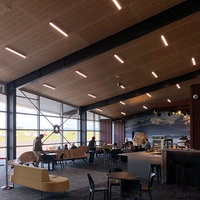
14. 2023 – Taupō Airport Terminal
1105 Anzac Memorial Drive, Wharewaka
Shelter Architects
Awarding an NZIA Local Award in 2023, the jury wrote that the building “is a simple shed form, located parallel to the runway for practicality and visual connection. But it has a twist — its roof ridge alignment that links the terminal to the landscape. Beneath this form, the terminal boasts generous raking eaves, full-height glazing and an efficient, functional layout. … At each end of the terminal, mural-scale photos by a local photographer inform visitors of their natural surrounds, while artwork tells the story of the volcanic region, and substantial rimu trunks offer a tactile connection to place.” Refer Architecture NZ Sep/Oct 2023.
WORTH THE DRIVE
Whakamaru Hydroelectric Power Station (1956)
Near the junction of State Highways 30 and 32, Whakamaru
Frederick H. Newman, Hydro Design Office, Ministry of Works
Ōhakuri Power Station (1961)
379 Ōhakuri Road, Ōhakuri
A. C. Vallenduk, Power Division, Ministry of Works
Described by Stacpoole and Beaven as “an architectural statement which successfully fuses technical and human requirements”.
Wairākei Resort Taupō (1981)
640 Wairākei Drive, Wairākei
Roger Walker
The Cove on the Lake (1986)
213 Lake Terrace, Waipāhīhī
Robert Mitchell Associates Refer Home & Building June/July 1986
Lake Edge Resort (1987)
275 Lake Terrace, Waipāhīhī
The Natusch Partnership Refer Home & Building April/May 1989
Kinloch Lodge (2015)
261 Kinloch Road, Kinloch
Patterson Associates
Recipient of an NZIA Sir Miles Warren Award for Commercial Architecture in 2017. Refer Interior Sept–Nov 2017
Te Whare Hono ō Tūwharetoa (2024)
67 Horomātangi Street
DCA Architects of Transformation
SOURCES
Many of the buildings included in this guide were published by the journals of the time, though not many of the architects included have made an impact in our history monographs. Peter Shaw’s New Zealand Architecture (Auckland: Hodder & Stoughton, 1991), for example, includes no local buildings, and John Stacpoole and Peter Beaven’s Architecture 1820–1970 (Wellington: AH & AW Reed, 1972) includes only the Ōhakuri Power Station. One thing this tells us is that Taupō has, unlike many similar-sized centres, been able to support a lineage of successful local architects and hasn’t had all of its plum commissions snaffled by big city firms. That said, JASMaD’s DeBrett’s is included in Stephen Stratford’s Jasmax (Auckland: New Zealand Architectural Publications Trust, 2007). From Dust and Ashes (Taupō, New Zealand: John Greenfield, 1996) by local historian John Greenfield tells in detail the story of the town’s historical development.
AND
Less frequent visitors to Taupō will note the reshaping of traffic routes through town and the dramatic new landscaping. The Taupō Town Centre Transformation project was produced by Taupō District Council’s in-house landscape team and Boffa Miskell, working with local artists and mana whenua.

The Itinerary series is supported by Dulux Colours of New Zealand. Dulux Colour Specialist Davina Harper has selected a Colours of New Zealand palette based on this itinerary. See the full range and order colour samples here.


